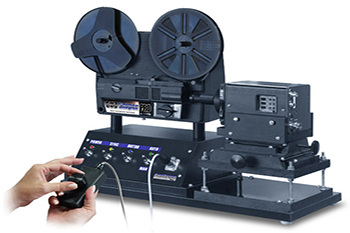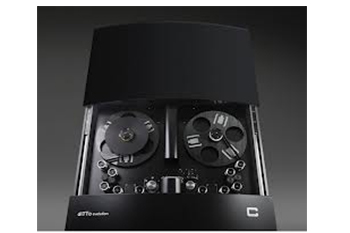
Film Conversion Equipment
Film Scanning and Film Transfer Equipment Types
The type of film scanning machine used for your 8mm, Super 8 or 16mm film conversion will have as much of an impact on the quality you receive as the resolution of the scan itself will. For example, if you wanted to digitize a photograph and tried doing it two different ways. You first put the photograph down on a table and took a picture of it using your smart phone or camera. Then you took the picture and scanned it using a flatbed scanner. If you compare the two side by side on your computer it will become really obvious that the flatbed scanner produced a digital image as good as the photograph. However, the picture you took with your phone or camera does not look close to the quality of the original photograph.
The same goes for scanning your 8mm, Super 8 or 16mm film. The real-time and frame by frame machines below are using a camcorder to take a picture of your film. The motion picture film scanner and Datacine machine are scanning the film. The results will be significantly different.
Film Conversion Equipment |
|
Real Time
|
|
Frame by Frame
|
|
Professional Film Scanners
|
|
Equally important as resolution is the type of film transfer. There are a few basic types of film transfer processes. More than 80% of the companies out there today use a real-time transfer. Any type of real-time film transfer will result in video that is 40-50% worse than the film’s current condition.
Pine Bluff Fun Facts: Pine Bluff, Arkansas, in Jefferson county, is 128 miles SW of Memphis, Tennessee. The city contains a population of approximately 55,085. Pine Bluff, Arkansas, in Jefferson county, is 128 miles SW of Memphis, Tennessee. The city contains a population of approximately 55,085.
Arkansas Fun Facts: Today Arkansas ranks 27th among the 50 states in area, but, except for Louisiana and Hawaii, it is the smallest state west of the Mississippi River. Its neighbors are Missouri to the north, Tennessee and Mississippi to the east, Louisiana to the south, Texas to the southwest and Oklahoma to the west. The name Arkansas was used by the early French explorers to refer to the Quapaw people—a prominent indigenous group in the area—and to the river along which they settled. The term was likely a corruption of akansea, the word applied to the Quapaw by another local indigenous community, the Illinois.








